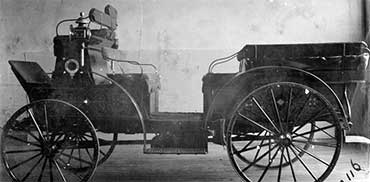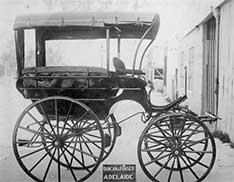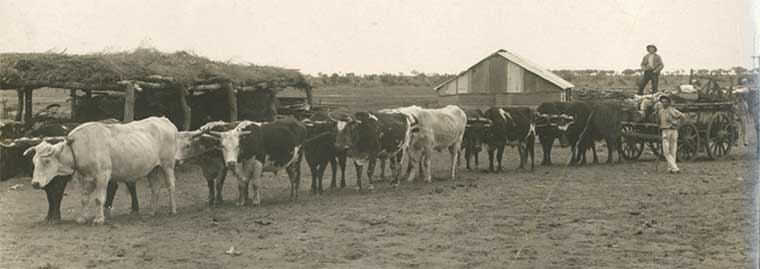A Settler's Experiences in the Tiers
A colonist of 1838 has left us with an evocative account of his experiences on a 'selection' 20 miles to the east of Adelaide:
Having sent on men to prepare timber for building and fencing, I followed as soon as temporary shelter was provided. I give an account of our journey as a fair specimen of what early settlers had to "experience".
I first dispatched two bullock teams with our furniture and fixings as early in the day as possible, and followed some hours afterwards with my family in a roomy wagonette, to which were harnessed, one in the lead and two wheelers - a dangerous rig for the rough and hilly track we had to pursue.


Left: State Library of South Australia: Duncan & Fraser wagonette drag [B 14103/124]. Duncan & Fraser were in Franklin Street, Adelaide.


Right: State Library of South Australia: Duncan & Fraser Wagonette [B 14103/2]. Duncan & Fraser wagonette with lock under forecarriage. Price 110 pounds.
In the trap, I being the driver, I had my wife, sister, two sons (three and four year old), one female servant, and our youngest boy in arms; also a man to assist in procuring timber drags, and on fixing them on the hind axle before I ventured to drive down the steep hills which we had to pass - in those days screw skids had not been invented. I must here mention that this great improvement in skids on all other plans which had been previously used in easing loaded vehicles down hills was shortly afterwards invented by one of our earliest colonists, Mr Stephen HACK. The first one which was constructed on his suggestion was made by J. ADAMSON.
To pass over the Mount Lofty Range at that time was no easy task. The first ascent was by either of the spurs between Beaumont and Glen Osmond. I fixed on the one nearest Greenhill as being most used and having much more space for making tacks. I had a staunch team and, with many zigzags, I surmounted this first difficulty, my man following behind with chocks to stop the hind wheels when necessary to ease the horses.
On the top of the brow on the first saddle, to my surprise and annoyance, I overtook the drays. The day being hot, one of my best leading bullocks dropped, and could not be got up again. I had in consequence to leave my man to assist in yoking up one of the body-bullocks as a makeshift leader in the place of the fallen one, and to continue with the drays to assist the disarranged team; and I had no alternative but to go on the best way I could without help or the use of drays. I could not leave the horses to cut young saplings for that purpose and to attach them to the drag chain.

State Library of South Australia: Bullock Team and Dray [B 10988]. Twelve pairs of bullocks (sic) are harnessed to this dray. A bullock team could only travel at three miles per hour and was slower than a horse team. Devon cattle were used as they were more plentiful, hardy and easier to match up with others on the team.
My next serious difficulty was Breakneck Hill, rightly named as I can speak from experience of broken necked bullocks in descending, but on this occasion I had to surmount it. When I came to the steep and longer descent at Cox's Creek, on which spur very fine trees had been felled and split into palings and shingles, the stumps of course left standing, and sundry rejected bad splitting pieces of timber lying about, I felt I had arrived at my worst trouble.
I pulled up and looked on each side, hoping to find at hand a suitable timber drag, but was disappointed; and with much trepidation I started the team at a foot's pace, but when the pressure became too heavy on my wheelers they began to trot in spite of all my efforts to hold them back and at length they broke into a full gallop. By the sagacity and obedience of my leader I was able to clear the stumps and logs without an accident. The females and children fortunately did not scream or utter a word.
At the foot of the hill, on pulling up, I found two men on horseback, who had paused in meeting us in astonishment at such a flying descent. Before I could gain my breath or speak to my family they addressed me most abruptly - I could see they were fresh arrivals. They said, "We wish we could hand you over to the police for driving down such a dangerous hill in such a reckless manner to the risk of your passengers' lives." I replied, "I excuse your ignorance, gentlemen; I am driving my wife and family. I have scarcely recovered from my fright. You have interrupted me and all of us in returning silent thanks for our deliverance from so great a danger. Look at my hands, black with the force I have used."
We continued on the track over the natural surface, now steep sideling, now sharp rise or fall, no pick or shovel having yet been used, and reached the Onkaparinga River without accident. The crossing was too rough and here one of our back springs gave way, after having stood all the heavy jolts and jars we had previously encountered.
A cross-bar, cut and fixed, we again passed on and reached the section at sundown. After a picnic supper we turned in on beds of dry grass, as the drays with bedding and food did not arrive till next morning. Poultry and dairy cows had been sent up some time before with a small flock of sheep.
The kitchen and dairy being finished we soon had our usual comforts. And now the work of fencing was continued, and grubbing trees, and preparing land for corn. An orchard and garden were trenched, to be ready at the right season for planting. I had purchased seed wheat as 15 shillings a bushel and, having to pay that price for seed, and so much to do in clearing, fencing, and erecting farm buildings, I did not crop more land the first season than what I thought might yield me seed for the following year and enough for domestic use.
At this time, on the first farms established, some of them quite unused to manual labour, might be seen undergoing the heaviest work their powers would admit of, their wives and children engaged in unaccustomed employment and totally unsuited to their strength; a boy of eight or ten years driving bullocks at harrow, occasionally a young girl driving bullocks for her father at plough, or with a sister cross-cutting logs for fencing; then all had to help at odd times of the day, early and late, at log burning.
All this toil was necessary, because labour was scarce and wages high, or money wanting, and so a variety of hard shifts had to be adopted to accomplish indispensable work.'



